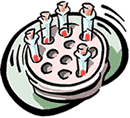Biomedical Waste (continued...)
Liquid biohazardous materials are to be properly inactivated or sterilized prior to disposal in the community sewage treatment system. Garbage disposal units are not to be used with contaminated materials because of the aerosols generated. Chemotherapy waste may not be disposed of in the community sewage; it must be incinerated in a permitted incinerator. Contract disposal services may be used.
Biomedical wastes may be treated so as to render it non-biomedical wastes. Properly treated wastes may be combined and handled with regular solid wastes. Biomedical wastes may be treated by autoclaving in a recording autoclave. Recording of the temperature during each complete cycle shall be used to assure the attainment of 121°C or 250°F for a minimum of 30 minutes in order to achieve decontamination of the entire load.
Several factors affect the steam sterilization process including load size, distribution and compaction, altitude above sea level, and heat penetration. Personnel responsible for sterilization may have to determine the appropriate time at standard autoclave temperature and pressure for certain loads of biohazardous materials.


